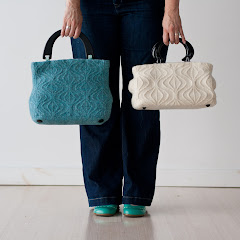 It's finally ready! My first handbag pattern...and she's a peach. The Billington Bag (click for Ravelry details) is now available for download through my Ravelry store; it'll also be available shortly from Knit Picks. It's a felted wool bag with fabric lining and cute little button feet, perfect for carrying your latest knitting project around. The extremely groovy texture comes from a twisted-stitch motif in one of the Barbara Walker treasuries, which I just cannot get enough of--the design practically invented itself as I looked at the chart in the book!
It's finally ready! My first handbag pattern...and she's a peach. The Billington Bag (click for Ravelry details) is now available for download through my Ravelry store; it'll also be available shortly from Knit Picks. It's a felted wool bag with fabric lining and cute little button feet, perfect for carrying your latest knitting project around. The extremely groovy texture comes from a twisted-stitch motif in one of the Barbara Walker treasuries, which I just cannot get enough of--the design practically invented itself as I looked at the chart in the book!Billington the bag is named for our current Librarian of Congress, Dr. James H. Billington. He's a heck of a guy--check out his 40 honorary doctorates in addition to the one he earned as a Rhodes Scholar at Oxford!--but I hold him in special esteem for the work he's done to acknowledge important works by amateur filmmakers, having named several remarkable home movies to the National Film Registry of the Library of Congress. (One of my all-time favorites is "Disneyland Dream" by Robbins Barstow, who is also a heck of a guy. You can watch it in its entirety via the Internet Archive.)
I'm particularly excited about this pattern, because it's the first one for which I'm pledging a portion of the proceeds to a cause that's really important to me: The Center for Home Movies. CHM runs the annual international Home Movie Day event, which is coming up on October 16 this year. On Home Movie Day, film archivists in cities around the world set up venues where members of the general public can bring in their family films (and sometimes videos) for inspection, assessment, and best of all, viewing. Many people haven't seen these family memories for decades (if ever) due to lack of a working projector or concerns about their condition, and they're therefore at risk of being lost due to neglect or simple ignorance of their rich contents. Several of the home movies now on the National Film Registry were re-discovered through Home Movie Day events, but every film that's shown at a Home Movie Day is special in some way.
In fact, home movies are stereotyped as being boring and badly shot, but I think they're actually a lot like handknits: They may run to hundreds or even thousands of yards, they're rich in color and visual texture, and they become so much more meaningful when they're handed down from generation to generation. All home movies and handknits are one-of-a-kind--not mass-produced--and so they uniquely reflect the people who made them, as well as the place and time in which they were made. They also take a little extra care and special handling to look their best, but the effort of storing them carefully and preventing snags and tears is definitely worth it. Showing them off to people who appreciate them is a special treat, too!
50% of the net sales from Billington Bag patterns will go to CHM to help support their work on preserving, presenting, and encouraging the use and study of historic amateur media. I've been involved with CHM since their very beginnings, and know how much they can do with even the smallest contributions. I hope you'll take a moment to mark your calendar and make plans to check out the Home Movie Day nearest you this year. You can bring your knitting!

Photos this post (c) 2010 by Caro Sheridan/Splityarn. That's her adorable cat, too.







